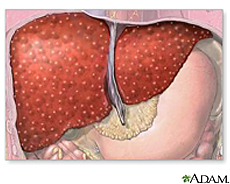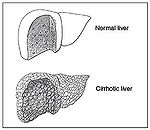Cirrhosis
Cirrhosis is a liver disease where there is irreversible scarring and damage of the liver. First, there must be repetitive damage done to the liver for cirrhosis to develop. This condition, if left untreated, will continue to develop over the years, which will untimely cause the liver to stop functioning[1].
A human liver can weigh approximately three pounds and it is the largest solid organ in the human body. This organ is responsible for many functions[2]:
- Creating the proteins in the blood which help with clotting, transport of oxygen, and the proper function of the immune system.
- Filtering nutrients in the blood.
- Forming bile for digestion
- Breaking down fats[2]
Symptoms
During the early stages of cirrhosis most people do not experience any obvious symptoms. Symptoms are more commonly show up when the damage has already spread and the condition worsens. Some of these symptoms can be, but are not limited to:[1].
- loss of appetite and weight
- itchy skin
- vomiting
- tenderness around the area of the liver
- red or blotchy looking palms [1]
- skin or eyes may turn a yellowish color
- swelling in the abdomen and leg regions[3]
As the condition worsens and continues to expand, different symptoms may flourish, like:
- increased heart rate[1]
- toxins in the blood can affect the brain causing changes in personality
- gums may become sensitive and start bleeding
- swelling of ankles, feet, and or legs
- some may start to lose hair
- having problems breathing
- Problems remembering things
- Staggered walking[1]
Causes
Each time that the liver is damaged it forms scar tissue as it tries to repair itself. Continuous damage to the liver cause the scar tissue to built up, making it extremely difficult for the liver to function properly. The scar tissue formed by the repetitive damage to the liver causes cirrhosis. When the cirrhosis becomes too advanced the live will not continue to function. Since humans cannot function without a liver the patient must receive a liver transplant[4].
There are different causes of cirrhosis. A fatty liver, long-term abuse of alcohol,and hepatitis B and C are the most common known causes of liver cirrhosis in the United States, but any kind of damage to the liver could cause cirrhosis. Some patients may even have multiple causes present at once. Other cause include[2]:
- The duct that carries bile from the liver may become blocked preventing the bile to reach the intestines. Bile helps break down the fats during digestion.
- Fluid being released into the lived due to recurring heart failure.
- Particular inherited diseases like : Cystic fibrosis,Glycogen storage diseases, Alpha 1 antitrypsin deficiency, and any kind of disease that causes the liver to function abnormally.
- Other less likely cause are: reactions to prescription drugs, long term exposure to environmental toxins, and infections through parasites[1].
ALCOHOL ABUSE
The liver breaks down toxins that are consumed, like alcohol. If the amount consumed is too high for the liver to break down, the liver will be overworked and start to damage. People that drink too much alcohol are more susceptible to developing cirrhosis. Usually it takes ten years for the cirrhosis to start to develop in the long-term drinker, but this varies with each person[1].
HEPATITIS
A hepatitis C infection can cause damage to the liver; leading to cirrhosis. Although most people are more likely to get cirrhosis from Hepatitis C, Hepatitis B and D can also cause it[1].
NON-ALCOHOLIC STEATOHEPATITIS(NASH)
People who are over weight, diabetics,those who have high blood lipid levels and [[high blood pressure/hypertension]. NASH occurs when the patient has a fatty liver[1].
GENETIC CONDITIONS
- Hemochromatosis - This occurs when too much iron builds up in the liver as well as other parts of the body.
- Wilson's disease - This occurs when copper builds up in the liver and other areas of the body.[1].
Finally, even though it is not likely, some prescription drugs may cause cirrhosis, as well as long exposure to toxins and infections transmitted by parasites.[2]
Diagnosis
A patient that is experiencing symptoms of cirrhosis can go to their primary care physician for testing. The doctor will start the examination by checking if the patients liver is enlarged. If any further analysis is needed the fallowing tests will be ordered;[1]
*Blood test - this blood test will determine if the liver is functioning properly. The patient might have hepatitis if the Alanine Transaminase levels are too high.
*Imaging tests- this imaging test can be done with an ultrasound, CT, or MRI scan of the liver. Performing these tests will show if there is any scaring or enlargement of the liver.
*A biopsy- Taking a tiny sample of the liver will be extracted and taken under the microscope for examination. A biopsy of the liver will confirm or rule out cirrhosis.
*Endoscopy- an endoscope will be slide down the patient's esophagus and into the stomach. During this examination he doctor will search for swollen blood vessels, which are a sign of cirrhosis.
*Child-Pugh Score- This determines the prognosis of cirrhosis and whether the patient needs a liver transplant. This system is a combination of numbered points and the letters A, B, C:[1]
| Class | Points | One year survival | Two year survival |
|---|---|---|---|
| A | 5-6 | 100% | 85% |
| B | 7-9 | 81% | 57% |
| C | 10-15 | 45% | 35%[1] |
Treatment
There is no cure for cirrhosis, but there are treatments that can help stop the progress of the condition. These treatments can reduce the damage already caused to the liver cells, and reduce complications that could occur later on. Any treatment given to a patient depends on what caused the cirrhosis.
- Alcohol abuse-the patient is told to stop all consumption of alcohol.
- Hepatitis- the patient will be prescribed with steroids or antiviral drugs.
Prevention of cirrhosis
Alcohol -It is important to drink a moderated amount of alcohol and not to go beyond the recommended limit.
- Men: no more than 21 units per week
- Women: no more than 14 units per week
- People who already have cirrhosis should not drink any alcohol at all. A continuance of alcohol consumption would cause the disease to spread at a faster rate.
References
- ↑ 1.00 1.01 1.02 1.03 1.04 1.05 1.06 1.07 1.08 1.09 1.10 1.11 1.12 Nordqvist,Christian. What Is Cirrhosis? What Causes Cirrhosis? Medical News Today. Web. Date-of-publication: 26 Nov 2009.
- ↑ 2.0 2.1 2.2 2.3 Author Unknown. Cirrhosis of the Liver webmd. Web. Date of access: November 01, 2012.
- ↑ Unknown Author. Cirrhosis PubMed Health. Web. Date of publication: October 16, 2011.
- ↑ Author Unknown. Cirrhosis mayoclinic. Web. Date of publication: January 22, 2011.
| ||||||||||||||||||||


